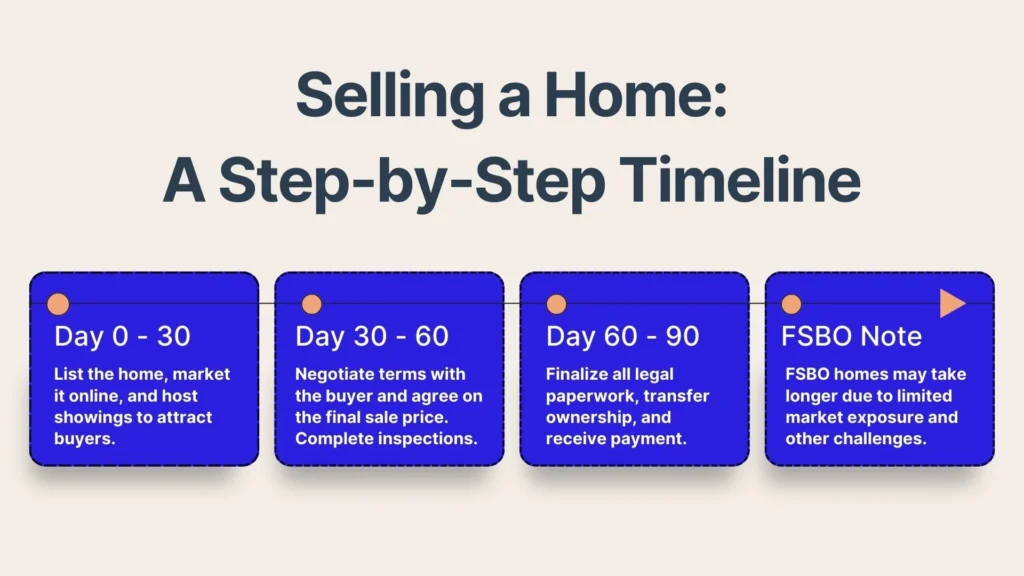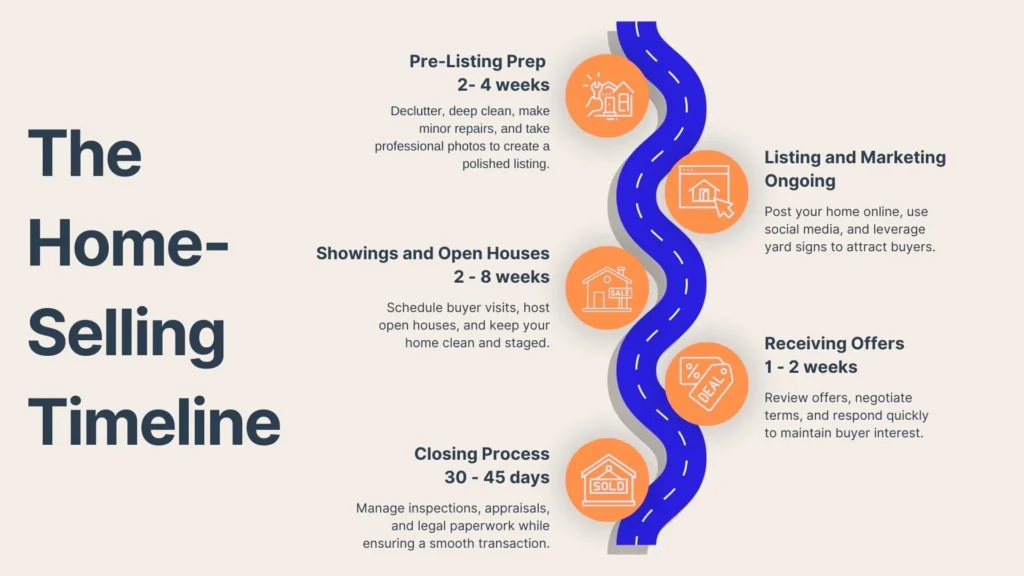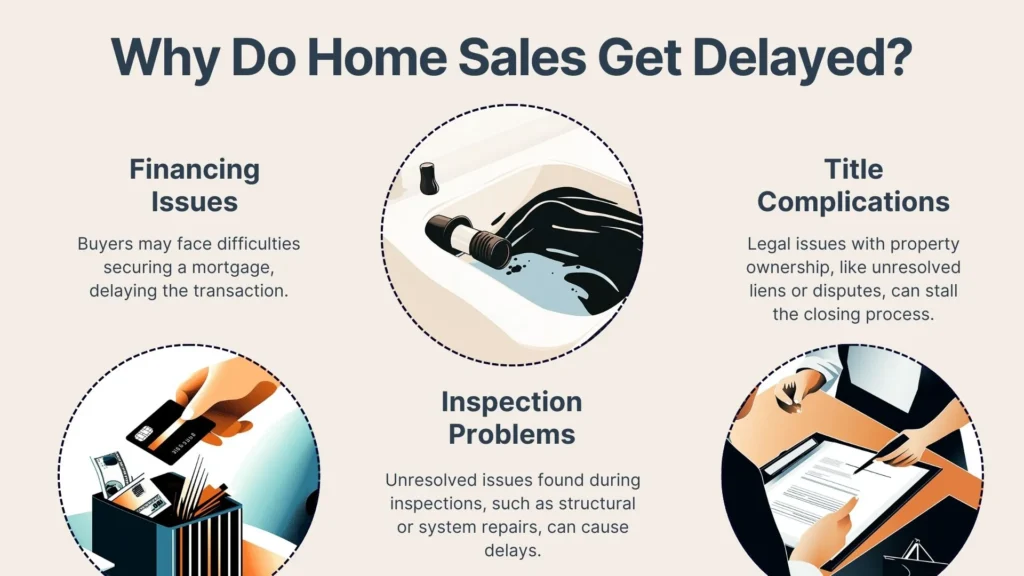Selling a home can be a complex process, especially for For Sale By Owner (FSBO) sellers. One of the most common questions FSBO sellers ask is, “How long will it take to sell my home?” The answer depends on a variety of factors, including market conditions and how effectively you price and market your property.
Statistics show that FSBO homes typically take longer to sell compared to agent-assisted transactions. For example, while 6% of home sales were FSBO in 2024, the typical FSBO home sold for $380,000, significantly less than the $435,000 median sale price for agent-assisted homes. This underscores the importance of understanding the timeline and strategies to maximize your FSBO success.
This guide breaks down the key factors influencing the time it takes to sell a home and provides actionable tips to streamline the process.
What Is The Average Time To Sell A Home?
The average time to sell a home in the U.S. varies depending on several factors, but generally, homes spend about 30 to 60 days on the market. However, FSBO homes may take longer to sell due to limited exposure compared to homes listed by agents on the Multiple Listing Service (MLS).

After accepting an offer, the closing process typically takes an additional 30 to 45 days. This means the total timeline for selling a home can range from 60 to 90 days or more, depending on how quickly you secure a buyer.
FSBO sellers should also be prepared for potential delays. According to the National Association of Realtors (NAR), 13% of FSBO sellers cite “selling within the planned time frame” as one of their biggest challenges.
What Factors Influence The Time It Takes To Sell A Home?
Several factors impact how quickly a home sells. Understanding these can help FSBO sellers identify areas where they can improve their approach.
Location
Location is a critical factor in determining the time it takes to sell a home.
- Urban areas: Homes in urban areas or popular neighborhoods tend to sell faster due to high buyer demand and proximity to amenities.
- Suburban areas: Suburban homes may take slightly longer to sell, particularly if the market is saturated with similar properties.
- Rural areas: Rural properties often take longer to sell due to a smaller buyer pool.
If your home is located near top-rated schools, public transportation, or major employers, be sure to highlight these features in your marketing efforts.

Market Conditions
Market conditions, such as whether it’s a seller’s or buyer’s market, heavily influence selling timelines:
- Seller’s market: Low inventory and high demand can lead to quicker sales and competitive offers.
- Buyer’s market: Higher inventory levels and reduced demand mean homes take longer to sell, and sellers may need to lower their asking price to attract buyers.
Pricing Strategy
Pricing is one of the most challenging tasks for FSBO sellers, with 17% citing it as their biggest obstacle. Overpricing your home can lead to extended time on the market, while underpricing may result in missed profit opportunities. Using tools like a comparative market analysis (CMA) and researching recent sales in your area can help you set a competitive and realistic asking price.
If you’re concerned about your pricing standing out, consider offering incentives to make the deal more appealing, like covering a portion of the buyer’s closing costs or including furniture in the sale. Such incentives can make buyers perceive additional value, even if your asking price is similar to others in the market.
Home Condition and Features
Homes in excellent condition tend to sell faster. Buyers are more likely to make offers on properties that are move-in ready and visually appealing. Investing in minor upgrades, such as painting, landscaping, or replacing outdated fixtures, can significantly boost your home’s appeal and reduce its time on the market.
If your home has features or upgrades that aren’t common in comparable properties – such as a recently renovated kitchen, energy-efficient windows, or a large backyard – be sure to factor these into your pricing. Highlighting these features in your listing description can justify a slightly higher price.
What Does The Typical Selling Process Timeline Look Like?
Selling a home involves several stages, each contributing to the overall timeline. Here’s a general picture of what the average home sale timeline looks like:

Pre-Listing Preparations
Timeline: 2-4 weeks
Before listing your home, you’ll need to prepare it for sale. This includes:
- Decluttering and deep cleaning: Remove unnecessary furniture, personal items, and knick-knacks to create a more open and neutral space. Pay extra attention to high-traffic areas like kitchens and bathrooms. Don’t forget to clean windows, baseboards, and light fixtures to make your home sparkle.
- Completing minor repairs or upgrades: Patch holes in walls, replace broken tiles, and repair leaky faucets or squeaky doors. Consider replacing outdated hardware like doorknobs, cabinet pulls, or light fixtures with modern options. Buyers notice these small details and may view them as signs of neglect if left unaddressed.
- Taking professional photos and crafting a compelling listing description: Professional photos make a significant difference in showcasing your home’s best features. Highlight your home’s key features and unique selling points. Mention updates, special amenities, and proximity to desirable locations like schools or shopping centers. Use descriptive language to paint a picture of what it’s like to live in the home.
Listing And Marketing
Timeline: Ongoing
Once your home is listed, marketing becomes a continuous effort until you find a buyer. According to NAR, 51% of buyers found their home online, making digital marketing crucial for FSBO sellers. Key marketing strategies include:
- Listing your home on popular websites like Zillow, Redfin, and FSBO-specific platforms.
- Promoting your property on social media.
- Using yard signs, which account for 4% of buyer discoveries.
Effective marketing increases your home’s visibility and attracts more potential buyers.
Showings And Open Houses
Timeline: 2-8 weeks
Showings and open houses are essential for generating buyer interest. Be prepared to:
- Schedule showings at convenient times for buyers.
- Host open houses to attract local interest.
- Keep your home clean and staged throughout this phase.
Feedback from potential buyers can also help you identify and address any concerns that may be slowing the sale.
Receiving And Negotiating Offers
Timeline: 1-2 weeks
Once you start receiving offers, it’s time to evaluate and negotiate terms such as price, contingencies, and closing timelines. FSBO sellers should be prepared to respond quickly and professionally to offers to maintain buyer interest.
Closing Process
Timeline: 30-45 days
The closing process involves several steps, including:
- The buyer securing financing (74% of buyers finance their home).
- Home inspections and appraisals.
- Completing legal and title paperwork.
FSBO sellers must stay involved during this stage to ensure the transaction proceeds smoothly.
How Can A Seller Speed Up The Home Selling Process?
There are several strategies you can try to accelerate the sale of your home Follow these suggestions to speed up your own home sale timeline:
Effective Marketing Strategies
The more exposure your home gets, the faster it’s likely to sell. Consider:
- Posting your listing on high-traffic websites.
- Using high-quality photos and videos to showcase your home.
- Writing a detailed and engaging listing description.
Social networking websites accounted for 3% of FSBO marketing methods in 2024, so don’t overlook their potential to reach buyers.
Competitive Pricing
Pricing your home correctly is one of the most effective ways to speed up the sale. Use a CMA to set a realistic asking price and consider pricing slightly below market value to generate buyer interest and multiple offers.
Home Staging And Improvements
Staging helps buyers envision themselves in your home, which can lead to faster offers. Key tips include:
- Declutter and depersonalize your space.
- Highlight key features with strategic furniture placement.
- Enhance curb appeal with fresh landscaping and a clean exterior.
Common Reasons For Delays In Home Sales
Despite your best efforts, some issues can delay the sale of your home. Here are some of the most common reasons for delays:

Buyer Financing Issues
Many buyers rely on financing, and problems can arise if:
- The buyer fails to secure a loan.
- The appraisal value is lower than the agreed sale price.
FSBO sellers can minimize delays by verifying that buyers are pre-approved for a mortgage.
Inspection And Appraisal Problems
Home inspections and appraisals can uncover issues that delay the sale, such as significant repair needs identified during the inspection and appraisals that don’t match the sale price. Addressing known issues before listing can help you avoid these setbacks.
Title And Legal Complications
Title issues, such as liens or unclear ownership, can also delay the closing process. Conducting a title search early can help identify and resolve any potential problems.
How Does The Time Of Year Affect Selling Speed?
Seasonal trends and weather conditions play a significant role in how quickly homes sell. Spring and summer are the busiest seasons for home sales, as families prefer to move during warmer months. Sales tend to slow during colder months, but serious buyers may still be active, leading to quicker transactions for well-priced homes.
Weather also impacts buyer demand. Mild weather encourages buyer activity, while extreme weather conditions, such as snowstorms or heatwaves, can reduce interest in open houses and showings.
Conclusion
While the average time to sell varies based on location, market conditions, pricing, and home condition, proactive strategies can help you achieve a quicker sale. While location, market conditions, pricing, and home condition influence your timeline, Propbox simplifies the process, helping you sell faster and with less stress.
With AI-enhanced tools, automated reminders, and real-time updates, Propbox organizes every step for you. Say goodbye to the 6% commission fee and hello to a streamlined experience where you stay in control. List your home with confidence, knowing you’ll sell for more, protect your interests, and move on to your next chapter seamlessly.
